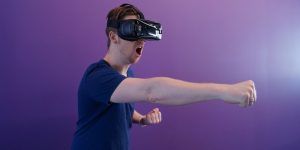What Is Virtual Reality Therapy? The Future of Psychology
 Imagine treating soldiers with post-traumatic stress disorder (PTSD) in a combat situation rather than an office.
Imagine treating soldiers with post-traumatic stress disorder (PTSD) in a combat situation rather than an office.
In 2012, the U.S. Naval Medical Center in San Diego, California, did just that – albeit virtually (Aldhous, 2012).
Soldiers were immersed in digital simulations of combat; the experience brought back to life through 3D images, sounds, vibrations, and even smells.
By working through their trauma in a simulation, soldiers previously unable to share were helped to talk about what had happened.
Virtual reality (VR) has proven to be a powerful tool to help people overcome PTSD and many other mental health issues including phobias, anxiety, and depression. This article explores the science behind the therapy, the treatments, and some of the software available.
Before you continue, we thought you might like to download these three Positive Psychology Exercises for free. These science-based exercises explore fundamental aspects of positive psychology, including strengths, values, and self-compassion, and will give you the tools to enhance the wellbeing of your clients, students, or employees.
This Article Contains:
What Is Virtual Reality Therapy?
Virtual reality aims to mirror “reality and create a world that is both immersive and interactive” (Maples-Keller, Bunnell, Kim, & Rothbaum, 2017). Success can be judged on the digital experience’s ability to simulate the real-world environment that it attempts to recreate.
And VR environments can feel very real.
In one ground-breaking study, researchers found that digital limbs (in VR) can feel indistinguishable from our own. After all, VR systems can induce physiological and psychological responses that can be measured by changes to stress hormones and other biological states (Bassolino et al., 2018; Martens et al., 2019).
Visually, the VR system components work together to “create sensory illusions that produce a more or less believable simulation of reality” (Bohil, Alicea, & Biocca, 2011). They appear authentic because they achieve brain and behavioral responses from virtual stimulation that mirror those in the real world.
Not only do experiences look and sound very real, but it is also possible to physically feel objects in the virtual world. Haptic gloves provide feedback – both texture and resistance – that simulates physical interaction within the digital environment.
Such a dynamic interaction allows the “user to engage with the VR environment in a more naturalistic and intuitive way” and gives the experience of being there (Maples-Keller et al., 2017).
And this is only the beginning.
A suit has been created that takes sensory feedback to the next level.
The Teslasuit looks like a wetsuit but is described as a “wearable computer on the surface of the skin” (Revell, 2018). More than that, the suit is electrified. It can cause muscles to move and warm/cool as needed to make a scenario breathtakingly real.
While it has obvious value for gamers, VR can also provide deeply immersive real-world training environments for people in hazardous professions – such as astronauts and rescue workers – or athletes trying to optimize performance. Staff can monitor movement, heart rate, and other indicators in real time or offline for later, in-depth analysis.
The potential for the therapist is equally thrilling. Traditional mental health interventions can be combined with cutting-edge technology to place clients in safe, controlled, and ecologically valid situations. As a result, VR offers a viable and valuable environment for safely recreating anxiety and other complex feelings (Martens et al., 2019).
The potential for virtual reality to simulate situations and social interactions is limitless. VR can transport the wearer into practically any contextually rich simulation while retaining control over the variables (Bohil et al., 2011). And while the experience is immersive and believable for the user, functional MRI recordings can compare psychological reactions with brain activity if needed.
And it works. VR therapy has successfully treated anxiety, PTSD, phobias, and depression.
So VR can look and even feel real. But how?
How Does It Work? A Look at the Psychology Behind It

To feel immersive and present, systems typically include two visual displays – one for each eye – that differ slightly, as they do when we view any object in the non-digital world.
For example, look at your finger with one eye closed, then swap with the other eye. You will notice a slight shift in the image.
Our brain takes inputs (artificial or real) from both eyes to create a 3D mental representation. The virtual world is made more realistic by adding additional sensory information: auditory stimuli enter through both ears to create a 3D spatial surround sound, and haptic feedback creates the sensation of “physical contact with the virtual world” (Bohil et al., 2011).
Perhaps the most fascinating part of VR is the ability of the wearer to interact with the environment. By moving the head, pointing at or grabbing something, or even redirecting our gaze, we can change the environment in front of us.
The degree of (sensorimotor) immersion reflects the amount of physical stimulation that we experience through our senses and the system’s sensitivity to receiving information about how we move.
Therefore, the sense of reality depends on the quality and quantity of the sensory experience and our ability to interact with the environment.
But why does it feel so real?
Because we feel present. Presence is our everyday experience of being here, sitting reading this article or walking through a virtual environment (Bohil et al., 2011). While immersion refers to how technically advanced the VR kit is, presence is psychologically and physiologically how it feels to be inside the experience. Typically, the more immersive the experience, the more present we feel.
Such increased presence is linked to multiple brain areas, notably higher activation in the parietal brain – crucial for spatial processing, navigation, and integrating sensory information to form a single perception (Baumgartner, Valko, Esslen, & Jäncke, 2006).
VR feels real because to the brain, it is.
A Look at VR Exposure Therapy and Phobias
Phobias are regularly treated using exposure therapy. This involves the controlled introduction of a situation or object that the patient fears.
The treatment typically begins with the patient imagining what they are scared of then gradually increasing the physical presence of the phobic stimulus. Over time, as the client perceives more control over the environment, they gain a sense of mastery over their fears (Bohil et al., 2011).
And it works in VR just as well as it does in the real world.
For example, virtual balconies and rooftops have been used to treat people with acrophobia (an extreme fear of heights). But it doesn’t end there. VR settings have also been successful in treating other phobias, including (Bohil et al., 2011; Maples-Keller et al., 2017):
- Arachnophobia – an intense fear of spiders
- Aviophobia – an extreme fear of flying
- Agoraphobia – the fear of open spaces and situations where escape is not possible
- Claustrophobia – an intense fear of being trapped in small spaces
- Glossophobia – the fear of public speaking
While there is still some uncertainty about whether virtual environments can invoke the same level of stressful responses as their physical counterparts, they continue to prove to be successful treatment tools. And as VR improves, the disparity between digital and real-world experiences reduces further.
For the therapist, VR is a valuable tool to facilitate and control emotional engagement in clients while working through their fears, anxiety, and trauma (Maples-Keller et al., 2017).
Treatment of Disorders: PTSD, Anxiety, and Depression

PTSD
VR exposure therapy has proven valuable in helping people with PTSD.
The therapist begins with an initial assessment of the patient’s needs based on the type and degree of trauma.
The VR environment can then be made specific to the individual and their requirements. For example, a particular time of day, noises specific to the equipment used (gun model or vehicle, etc.), and the landscape can be personalized (Maples-Keller et al., 2017).
Research has shown a significant reduction in anxiety when virtual reality is used to treat people exposed to terror attacks – such as on September 11, 2001 – disasters, and war. As few as six one-hour VR sessions can reduce anxiety by up to 90% (Difede, Hoffman, & Jaysinghe, 2002; Difede & Cukor, 2007).
Anxiety
Anxiety disorders are the most common mental health disorder in adults. In addition to causing significant distress, they can significantly impair a patient’s quality of life. And yet, despite clear evidence of exposure therapy’s effectiveness, it remains an underused treatment for anxiety disorders due to cost, availability, and logistical challenges (Boeldt, McMahon, McFaul, & Greenleaf, 2019).
Virtual Reality Exposure Therapy (VRET) is seen as a valuable and effective treatment for fear and anxiety. It offers a way of increasing the availability of such treatment while ensuring standardization.
Based on the emotion-processing theory, fear memories are thought to be structures that contain information about our fears, including stimuli, meaning, and responses. VRET systems facilitate emotional processing by immersing the patient in a tailored environment specific to those fear structures (Maples-Keller et al., 2017).
The anxiety reduction seen in the virtual environment over repeated exposures generalizes well to real life.
Due to the high degree of success in treating anxiety, VRET may, in the future, form part of a standardized approach to e-therapy.
Depression
People with depression can exhibit low mood symptoms, poor appetite, disturbed sleep, lack of energy, and feelings of worthlessness. Not only is VR seen as a cost-effective tool for helping people with anxiety, but ongoing research also confirms its value as a treatment for depression (Fodor et al., 2018).
The use of VR has led to a significant reduction in symptoms in clients with depression, but further research is required to find the optimal balance with existing treatments (Zeng, Pope, Lee, & Gao, 2018).
10 Benefits of VR-Based Therapy
While VR should be seen as a tool rather than the answer to every mental health challenge faced by a client, it does offer several advantages (Boeldt et al., 2019; Bohil et al., 2011; Maples-Keller et al., 2017):
- A high degree of ecological validity. The environments within such a digital reality are increasingly complex and believable.
- Direct control over the environment and degree of exposure. For example, when treating a fear of flying, turbulence can be removed or included, as required.
- Settings can be made incredibly relevant and personal by including objects, sounds, and even smells from a client’s past.
- Therapy can be more consistent and either repeatable or progressive.
- Stimuli can be introduced gradually and removed as needed. For example, a fear of spiders can be handled delicately and stopped when needed.
- Software is becoming increasingly easy to use and can be adapted for the therapist’s specific needs.
- Sessions are available for replay, and results can be collected for ongoing assessment.
- VR may provide the only option for difficult-to-arrange exposure therapy scenarios; for example, bad weather flying, facing large audiences, and handling dangerous environments.
- The therapy is more acceptable than reconstructing a real environment for patients who have been through trauma.
- It is helpful for clients who are unable to picture the situation sufficiently to produce their normal levels of anxiety.
Ultimately patients have reported high levels of satisfaction with VR treatment, probably due to the sense of control it offers and its effectiveness as a therapy (Maples-Keller et al., 2017).
The potential for VR in therapy is incredible and exciting. Success using such immersive technology has the potential to help the lives of those experiencing (Bohil et al., 2011; Maples-Keller et al., 2017):
- Phobias – through controlled exposure to the feared object or situation
- Social anxiety disorder – virtually meeting new people and speaking publicly
- Post-traumatic stress disorder – alongside, and in some cases replacing, existing treatments
- Generalized anxiety disorder – in conjunction with biofeedback, a valued approach for learning relaxation techniques
- Panic disorder – helping clients by repeatedly presenting situations that cause panic
- Acute and chronic pain – decreasing pain through distraction rather than a drug regime
- Addiction – providing safe and controlled exposure to drug-related cues
The above list only tells part of the story. While further work and exploration of the benefits continue in all the above areas of mental health, research breaks new ground in schizophrenia, autism, eating pathology, promoting cardiovascular health, and the mental health benefits of exercise (Zeng et al., 2018).
4 Apps and Software

Consisting either of specialist head-mounted equipment or utilizing modern smartphone power, popular headset options include Oculus Rift, Samsung Gear VR, and HTC Vive (Zeng et al., 2018).
Software and systems are increasingly being designed specifically for therapists and the support of mental wellbeing.
Currently, most VR environments have been created to treat anxiety disorders through exposure therapy, safely confronting the client with anxiety-inducing stimuli in a controlled environment. Clients can attempt situations impossible in the real world, such as jumping off virtual cliffs (Martin, 2019).
Four commercially available systems for psychology professionals include:
Psious
Over 2,000 health professionals use the Psious VRET to treat mental health conditions including:
- Phobias
- Depression
- Obsessive–compulsive disorder
- Social anxiety
- Generalized anxiety
- Eating disorders
The platform, backed up by several research studies, offers VR experiences that adapt to the client’s biofeedback in real time.
For example, therapists working with clients who fear flying can use an immersive experience that takes the VR wearer from leaving home to waiting at the boarding gate to taking the flight. For depression, the VR system provides environments to help evaluate the client and information to help identify appropriate treatments.
Among the 70 environments available, there are tools designed to promote mindfulness, helping clients become more attentive.
Virtually Better
Virtually Better provides tailored VR treatments that allow therapists to control their clients’ sensory experiences. Virtually Better’s exposure therapy takes clients through virtual scenarios to help with:
- Phobias (including fear of flying, heights, and storms)
- Addictions
- PTSD
Check out the company’s video to get an in-depth understanding of the experience.
The company’s VR treatments are supported by partnerships with over 60 research projects in offices, educational organizations, and classrooms across multiple countries.
Applied VR
Applied VR offers systems and training that support the treatment of anxiety, stress, and pain management and is used by over 30,000 patients in over 200 hospitals.
The system contains over 40 immersive environments, including meditation and breathing exercises, distraction games, and virtual visits worldwide.
The company promotes VR as a healthier alternative to medication, citing faster recovery times.
Virtue Health
Virtue Health offers several VR solutions to treat age-related conditions.
Their LookBack digital therapy has won awards for its work in improving care for people with dementia.
Teaming up with the University of Oxford, Virtue Health creates virtual tours of patients’ favorite places to promote reminiscence and cognitive stimulation.
A Take-Home Message
It typically takes 20 years from the publication of new research before the techniques become commonplace. Articles exploring the use of VR as a reality therapy technique began to appear in 1995. Over 20 years later, VR has become a viable tool comparable to its real-world counterpart.
While initially VR was expensive, difficult to set up, and unreliable, the technology is now widely available, and costs have fallen dramatically (Maples-Keller et al., 2017).
It is unlikely that VR will answer all our needs as therapists, but it compares favorably to existing treatments. As systems improve and the immersion level increases, it becomes an increasingly valuable tool for placing a client safely (back) into a complex and challenging environment. Once there, they can work through difficult emotions, anxiety, and fear and identify valuable coping techniques.
While the focus of VR has been on helping people overcome difficulties resulting from mental health problems, the scope for promoting and maintaining positive mental wellbeing is wide open.
In the future, we may be visiting a gym for our physical exercise and virtual environments to keep in good shape mentally.
We hope you enjoyed reading this article. Don’t forget to download these Positive Psychology Exercises for free.
- Aldhous, P. (2012). Virtual reality provides relief from soldiers’ trauma. NewScientist. Retrieved October 18, 2020, from https://www.newscientist.com/article/dn21822-virtual-reality-provides-relief-from-soldiers-trauma/
- Bassolino, M., Franza, M., Ruiz, J. B., Pinardi, M., Schmidlin, T., Stephan, M., … & Blanke, O. (2018). Non‐invasive brain stimulation of motor cortex induces embodiment when integrated with virtual reality feedback. European Journal of Neuroscience, 47(7), 790–799.
- Baumgartner, T., Valko, L., Esslen, M., & Jäncke, L. (2006). Neural correlate of spatial presence in an arousing and noninteractive virtual reality: An EEG and psychophysiology study. CyberPsychology & Behavior, 9(1), 30–45.
- Boeldt, D., McMahon, E., McFaul, M., & Greenleaf, W. (2019). Using virtual reality exposure therapy to enhance treatment of anxiety disorders: Identifying areas of clinical adoption and potential obstacles. Frontiers in Psychiatry, 10.
- Bohil, C. J., Alicea, B., & Biocca, F. A. (2011). Virtual reality in neuroscience research and therapy. Nature Reviews Neuroscience, 12(12), 752–762.
- Difede, J., Hoffman, H., & Jaysinghe, N. (2002). Innovative use of virtual reality technology in the treatment of PTSD in the aftermath of September 11. Psychiatric Services, 53, 1083–1085.
- Difede, J., & Cukor, J. (2007). Virtual reality exposure therapy for the treatment of posttraumatic stress disorder following September 11, 2001. The Journal of Clinical Psychiatry, 68(11), 1682–1689.
- Fodor, L. A., Coteț, C. D., Cuijpers, P., Szamoskozi, Ș., David, D., & Cristea, I. A. (2018). The effectiveness of virtual reality based interventions for symptoms of anxiety and depression: A meta-analysis. Scientific Reports, 8(1).
- Maples-Keller, J. L., Bunnell, B. E., Kim, S.-J., & Rothbaum, B. O. (2017). The use of virtual reality technology in the treatment of anxiety and other psychiatric disorders. Harvard Review of Psychiatry, 25(3), 103–113.
- Martens, M., Antley, A., Freeman, D., Slater, M., Harrison, P., & Tunbridge, E. (2019). It feels real: physiological responses to a stressful virtual reality environment and its impact on working memory. Journal of Psychopharmacology, 33(10), 1264–1273.
- Martin, S. (2019). Virtual reality might be the next big thing for mental health. Scientific American. Retrieved October 21, 2020, from https://blogs.scientificamerican.com/observations/virtual-reality-might-be-the-next-big-thing-for-mental-health/
- Revell, T. (2018). Suit that gives you electric shocks makes VR more realistic. NewScientist. Retrieved October 18, 2020, from https://www.newscientist.com/article/2165540-suit-that-gives-you-electric-shocks-makes-vr-more-realistic/
- Zeng, N., Pope, Z., Lee, J., & Gao, Z. (2018). Virtual reality exercise for anxiety and depression: A preliminary review of current research in an emerging field. Journal of Clinical Medicine, 7(3), 42.
Let us know your thoughts
Read other articles by their category
- Body & Brain (42)
- Coaching & Application (54)
- Compassion (26)
- Counseling (50)
- Emotional Intelligence (24)
- Gratitude (18)
- Grief & Bereavement (21)
- Happiness & SWB (40)
- Meaning & Values (25)
- Meditation (20)
- Mindfulness (44)
- Motivation & Goals (43)
- Optimism & Mindset (32)
- Positive CBT (25)
- Positive Communication (20)
- Positive Education (45)
- Positive Emotions (30)
- Positive Leadership (14)
- Positive Psychology (32)
- Positive Workplace (33)
- Productivity (16)
- Relationships (41)
- Resilience & Coping (34)
- Self Awareness (20)
- Self Esteem (36)
- Software & Apps (13)
- Strengths & Virtues (30)
- Stress & Burnout Prevention (34)
- Theory & Books (44)
- Therapy Exercises (35)
- Types of Therapy (58)




What our readers think
Hi. Can the people in the VR scenarios be personalized as well as the other aspects?
Thanks so much for a great article!
Hi George,
The level of personalization in VR scenarios can vary, but it is generally possible to customize aspects like avatars, environments, interactions, and user experience. Some advanced systems even use behavioral analytics and AI to adapt the experience in real time. However, the extent of these features depends on the specific VR platform and software being used.
I hope this answers your question! 🙂
Kind regards,
Julia | Community Manager
Hi Jeremy, Great article! I’m a Licensed Professional Counselor in Colorado and I’ve been trying to find out if special training is required to provide VR but with no luck. I thought maybe you know? Thank you for any information. Regards, CindiHK
Hi Cindi,
Glad you liked the article! Although I can’t imagine there are formal licensing or training requirements for this form of therapy (yet) beyond normal licensure to practice counseling/therapy, it would obviously be sensible to undergo some training first given the newness of the practice. The Society for Virtual Reality Therapy website includes a list of different training providers here, as well as other relevant organizations and resources.
I hope this helps!
– Nicole | Community Manager
Amazing information. Thank you